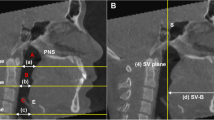Abstract
Background
Orthognathic surgery involves movement of jaws in all three planes, and this being a part of airway complex, displacement of jaws can influence the dimension of airway at all levels. Lefort one osteotomy surgery with superior repositioning is a common procedure done for patients with vertical maxillary excess
Purpose
The purpose of this study was to evaluate the three-dimensional volumetric changes in airway after lefort one impaction surgery using three-dimensional cone beam computed tomography (3D-CBCT) in patients with vertical maxillary excess (VME).
Methods
A prospective analysis of 15 patients who underwent isolated lefort one impaction surgery was done with pre-operative (T0) and 3-months (T1) post-operative 3D-CBCT scans. Airway was divided into three segments, nasopharyngeal, velopharyngeal and oropharyngeal. Volumetric analysis of all these segments was done before and after surgery. Paired ‘t test’ was used to assess the mean difference in airway volume and area between T0 and T1. One-way ANOVA was used to check the mean percentage difference in airway volume and area among the three segments.
Results
The mean percentage of nasopharyngeal volume difference was − 0.6299 ± 0.9146%, velopharyngeal volume difference was − 0.5205 ± 1.107%, oropharyngeal volume difference was − 1.492 ± 2.745%. Though volume and area of pharyngeal airway were decreased after maxillary impaction surgery in all three segments of airway studied, they were not statistically significant.
Conclusion
Among the three segments of airway studied, oropharyngeal airway volume has shown the highest post-surgical reduction though statistically insignificant. ESS scores were within normal limits. Hence, we are of the opinion that there is lack of evidence to conclude that the patients undergoing lefort one superior repositioning for the treatment of VME might develop significant narrowing of PAS that may predispose the patient to breathing disorders.






Similar content being viewed by others
References
Guilleminault C, Riley R, Powell N (1985) Sleep Apnoea in normal subjects following mandibular osteotomy with retrusion. Chest 88:776–778
Riley R, Powell N, Guilleminault C (1987) Obstructive sleep apnea syndrome following surgery for mandibular prognathism. J Oral Max Surg 45:450–452
Riley R, Powell N, Guilleminault C (1980) Maxillary, mandibular and hyoid advancement for treatment of obstructive sleep apnea: review of 40 patients. J Oral Max Surg 48:20–26
Abbott MB, Donnelly LF, Dardzinski BJ (2004) Obstructive sleep apnea: MR imaging volume segmentation analysis. Radiology 232:889–892
Donnelly LF, Surdulescu V, Chini BA (2003) Upper airway motion depicted at cine MR imaging performed during sleep: comparison between young patients with and those without obstructive sleep apnea. Radiology 227:239–243
Bhattacharyya N, Blake SP, Fried MP (2000) Assessment of the airway in obstructive sleep apnea syndrome with 3-dimensional airway computed tomography. Otolaryngol Head Neck Surg 123:444–448
Guilleminault C, Hill MH, Simmons FB (1997) Passive constriction of the upper airway during central apneas: fiberoptic and EMG investigations. Respir Physiol 108:11–16
Armstrong JJ, Leigh MS, Sampson DD (2006) Quantitative upper airway imaging with anatomic optical coherence tomography. Am J Respir Crit Care Med 173:226–231
Tso HH, Lee JS, Huang JC (2009) Evaluation of the human airway using cone-beam computerized tomography. Oral Surg Oral Med Oral Pathol Oral Radiol Endod 108:768–772
Hong Ji-Suk, Park Yang-Ho, Kim Yoon-Ji, Hong Soon-Min, Kyung-Min Oh (2011) Three-dimensional changes in pharyngeal airway in skeletal class III patients undergoing orthognathic surgery. J Oral Maxillofac Surg 69:e401–e408
Chen F, Terada K, Hua Y, Saito I (2007) Effects of bimaxillary surgery and mandibular setback surgery on pharyngeal airway measurements in patients with Class III skeletal deformities. Am J Orthod Dentofac Orthop 131:372–377
Pereira-Filho VA, Castro-Silva LM, de Moraes M, Gabrielli MF, Campos JA, Juergens P (2011) Cephalometric evaluation of pharyngeal airway space changes in class III patients undergoing orthognathic surgery. J Oral Maxillofac Surg 69:409–415
Degerliyurt K, Ueki K, Hashiba Y (2009) The effect of mandibular setback or two-jaws surgery on pharyngeal airway among different genders. Int J Oral Maxillofac Surg 6:647–652
Tselnik M, Pogrel MA (2000) Assessment of the pharyngeal airway space after mandibular setback surgery. J Oral Maxillofac Surg 58:282–285
Jakobsone G, Stenvik A, Espeland L (2011) The effect of maxillary advancement and impaction on the upper airway after bimaxillary surgery to correct class III malocclusion. Am J Orthod Dentofac Orthop 139:369–376
Daniel PB, Leandro V, Leonardo K, Monica Tirre DS (2014) Prediction of 3-dimensional pharyngeal airway changes after orthognathic surgery: a preliminary study. Am J Orthod Dentofac Orthop 146:299–309
Lee JY, Kim YI, Hwang DS, Park SB (2013) Effect of maxillary setback movement on upper airway in patients with class III skeletal deformities: cone beam computed tomographic evaluation. J Craniofac Surg 24:387–391
Mchanwell S (2016) Gray’s Anatomy: the anatomical basis of clinical practice. 41st edn. c2016. Section-4, Chapter 34, Pharynx; p 571, Elsevier
Buchanan A, Cohen R, Looney S, Kalathingal S, De Rossi S (2016) Cone-beam CT analysis of patients with obstructive sleep apnea compared to normal controls. Imaging Sci Dent 46(1):9–16
Chen H, Aarab G, de Ruiter MH, de Lange J, Lobbezoo F, van der Stelt PF (2016) Three-dimensional imaging of the upper airway anatomy in obstructive sleep apnea: a systematic review. Sleep Med 21:19–27
Acknowledgements
We thank M/s Essential Dental Products, New Delhi, for helping us with the Dolphin software.
Author information
Authors and Affiliations
Corresponding author
Ethics declarations
Conflict of interest
The authors declare that they nave no conflict of interest.
Rights and permissions
About this article
Cite this article
Vijayakumar Jain, S., Muthusekhar, M.R., Baig, M.F. et al. Evaluation of Three-Dimensional Changes in Pharyngeal Airway Following Isolated Lefort One Osteotomy for the Correction of Vertical Maxillary Excess: A Prospective Study. J. Maxillofac. Oral Surg. 18, 139–146 (2019). https://doi.org/10.1007/s12663-018-1113-4
Received:
Accepted:
Published:
Issue Date:
DOI: https://doi.org/10.1007/s12663-018-1113-4




